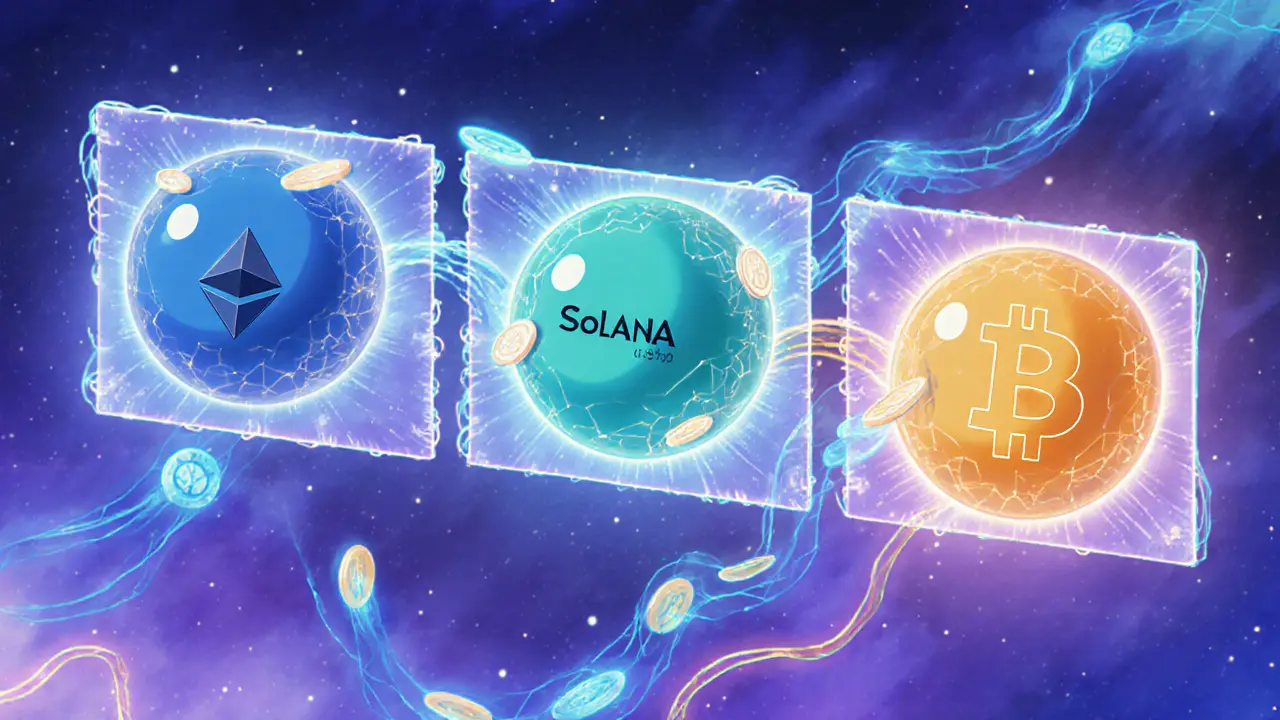Interoperability Approach Calculator
Compare Interoperability Approaches
Select your chain types and interoperability approach to see the trade-offs between cost, latency, security, and complexity.
Your Configuration
Key Considerations
This tool simulates trade-offs between different interoperability approaches based on the article's technical analysis. Real-world implementations may vary based on specific implementations, security measures, and network conditions.
Ever wonder why you need three different wallets to move the same token across Ethereum, Solana, and Bitcoin? The root cause is fragmentation - every chain lives in its own silo. Modular blockchain interoperability promises to dissolve those silos, letting users and developers treat many networks as one seamless ecosystem. Below you’ll learn what this means, how it works, and what to watch out for if you plan to build or use cross‑chain solutions.
Key Takeaways
- Modular blockchains split execution, consensus, settlement, and data availability into separate layers.
- Interoperability hinges on four pillars: cross‑chain messaging, asset portability, smart‑contract composability, and shared security.
- 1‑to‑1 solutions connect two chains efficiently; n‑to‑1 solutions aim to coordinate dozens of chains at once.
- Polkadot’s Relay Chain and XCM protocol are the most mature real‑world example.
- Orchestration frameworks (e.g., Li.Fi, Light) abstract the complexity for end users, but security remains the biggest risk.
What is Modular Blockchain Interoperability?
At its core, a modular blockchain is a network that separates the traditional monolithic stack into distinct layers - execution, consensus, settlement, and data availability - each of which can be upgraded or replaced independently. This design was first championed by Dr. Gavin Wood, who built Polkadot as a heterogeneous multichain framework.
When we talk about interoperability in this context, we mean the ability for any two (or many) of those layers, possibly belonging to different blockchains, to exchange data, tokens, and execution results without sacrificing the specialized function of each layer. In practice, this lets a DeFi app on a low‑cost rollup call a smart contract on Ethereum for price data, or a gaming protocol move an NFT across chains in a single click.
Four Pillars That Make Interoperability Possible
Almost every interoperability solution builds on the same set of technical components. Understanding them helps you evaluate claims and design better systems.
-
Cross‑chain messaging carries verifiable packets of information - think of them as secure emails - between networks. The message includes a proof (often a Merkle proof) that the source chain agreed on the payload, allowing the destination chain to trust it without a trusted third party.
-
Asset portability ensures that tokens retain their value and identity when they hop across chains. This is usually done via lock‑mint or burn‑mint patterns, but advanced schemes like token‑level anchors can keep the original token ID intact.
-
Smart‑contract composability lets a contract on Chain A invoke a function on Chain B as if it were a local call. Projects such as Cross‑EVM and Cosmos IBC expose proxy contracts that translate the remote call into a local transaction.
-
Shared security model guarantees that cross‑chain interactions inherit the security guarantees of the strongest participating network. Polkadot’s Relay Chain, for example, provides a single validator set that secures all attached parachains, eliminating the need for each chain to police its own bridge.

1‑to‑1 vs. n‑to‑1 Interoperability
Most early solutions - bridges, liquidity routers, and messaging protocols - are designed for a single pair of chains. They work well for moving assets between Ethereum and Polygon, but they hit a wall when an application needs to query state from dozens of rollups at once.
| Aspect | 1‑to‑1 | n‑to‑1 |
|---|---|---|
| Typical use case | Simple token bridge or DEX pair | Cross‑chain DEX with global pricing, multi‑chain NFT marketplace |
| Message cost | Low (single hop) | High (multiple hops, aggregation) |
| Latency | Sub‑second to a few seconds | Potentially tens of seconds, depends on orchestration |
| Security model | Bridge‑specific audits | Needs shared security or aggregated proofs |
| Scalability | Linear with number of pairs | Requires fan‑out architectures or hub‑spoke designs |
Because n‑to‑1 solutions must handle many concurrent states, they often rely on orchestration layers that batch messages, cache proofs, and compress data. Without such layers, a cross‑chain DEX would be too slow and too expensive to run in production.
Polkadot and XCM - A Live Example
Polkadot’s architecture exemplifies modular interoperability. The Relay Chain provides consensus and a shared validator set. Individual parachains or rollups handle execution for specific use cases - DeFi, NFTs, or data availability - whatever you need.
Communication happens through the Cross‑Consensus Messaging format (XCM). XCM is a lightweight instruction set that lets one parachain tell another, “lock this amount of token X and mint an equivalent on your chain.” Because the Relay Chain validates each XCM packet, there is no need for a separate bridge contract, and the security guarantees flow directly from the Relay Chain’s validator set.
The result? A user can move assets from a high‑throughput rollup to the Relay Chain and then to another parachain in a single transaction flow. This model has driven a 300% growth in the modularity and chain‑abstraction ecosystem over the past year, with dozens of new rollups launching on Polkadot and its sibling network, Kusama.
Orchestration Frameworks - Making Multi‑Chain UX Human
If you’ve ever tried to move a token via a bridge, you know the process is confusing: pick the source chain, the destination chain, the bridge contract, approve the token, and finally submit. Orchestration projects aim to hide that maze.
Three sub‑components make this possible:
- Account abstraction - Projects like Avocado let users sign actions with a single smart‑account that can act on many chains, removing the need for separate private keys.
- Wallet abstraction - Solutions such as OneBalance or Particle Network present a unified UI where the same address appears on Ethereum, Solana, and Avalanche.
- Orchestration frameworks - Platforms like Li.Fi or Light coordinate the underlying messages, batch them when possible, and guarantee atomicity (all‑or‑nothing) across chains.
For developers, this means you can write a single front‑end that calls an orchestrator API, and the orchestrator will handle the cross‑chain calls, token locks, and proof verification behind the scenes.

Security: Lessons from Bridge Hacks
Cross‑chain bridges are high‑value targets. The 2022 Ronin bridge hack, which drained $600million, showed that a single vulnerable validator set can collapse an entire ecosystem. Other incidents on Wormhole, Nomad, and Polygon’s PoS bridge echo the same theme: complexity breeds risk.
Key takeaways for anyone building or using cross‑chain infrastructure:
- Prefer shared‑security models (e.g., Polkadot’s Relay Chain) over independent bridges whenever possible.
- Audit every proof verifier and message decoder; a single bug can let attackers forge tokens.
- Use multi‑sig or threshold validator sets for bridge governance - a single compromised key should not give full control.
- Implement time‑locked withdrawal and fraud proofs to give users a window to contest suspicious moves.
Orchestration frameworks that rely on a hub‑and‑spoke design inherit the hub’s security model, so choose frameworks built on well‑audited hubs or proven consensus layers.
Future Outlook - Towards True n‑to‑1 Interoperability
What will the next generation look like? Expect three trends to converge:
- Layer‑0 hubs that provide universal proof systems (e.g., zk‑Rollup aggregators) allowing dozens of rollups to publish succinct proofs that any other chain can verify instantly.
- Dynamic fee markets where the orchestrator automatically routes messages through the cheapest path, swapping between Layer‑1, Layer‑2, and sidechains in real time.
- Standardized abstraction layers - similar to how HTTP standardized web communication, we’ll see a “XCM‑2.0” or “IBC‑3” that all new chains adopt, making it trivial to plug into existing hubs.
When those pieces click together, a cross‑chain DEX could query liquidity across 50 rollups, compute a global price, and settle the trade in under five seconds with a single transaction from the user’s perspective. Until then, developers should start by building on proven hubs, keep their architecture modular, and stay vigilant about security.
Practical Checklist for Builders
- Identify the core layers you need (execution, data availability, settlement).
- Choose a shared‑security hub (Polkadot, Cosmos Hub, or emerging Layer‑0).
- Implement cross‑chain messaging via a standard protocol (XCM, IBC, or a proven bridge SDK).
- Wrap token transfers in lock‑mint patterns with reversible fraud proofs.
- Integrate an orchestration SDK (Li.Fi, Light) to hide message complexity from users.
- Run a formal security audit focusing on proof verification and replay protection.
- Test end‑to‑end flow across at least three chains before mainnet launch.
Frequently Asked Questions
What’s the difference between a bridge and modular interoperability?
A bridge usually connects two specific chains with custom code and often needs its own security layer. Modular interoperability uses a shared hub or standardized messaging (like XCM) that lets many chains talk without separate bridges, preserving each chain’s specialized architecture.
Can I achieve n‑to‑1 interoperability on Ethereum alone?
Not directly. Ethereum can host a hub contract that aggregates proofs from other rollups, but you still need external validators or Layer‑0 support to verify those proofs efficiently. Pure Ethereum‑only solutions scale poorly for dozens of chains.
Is Polkadot the only platform with shared security?
No. Cosmos uses a Hub‑and‑Zone model with the Cosmos Hub, and newer Layer‑0 projects like Celestia and Fuel are building similar shared‑security concepts. Each has its own trade‑offs in latency and validator economics.
How do orchestration frameworks ensure atomicity across chains?
They lock assets on the source chain, emit a provable message, and only release or mint assets on the destination once the proof is verified. If any step fails, the lock is reverted, giving an all‑or‑nothing outcome.
What’s the biggest security risk right now?
Complex, custom bridge code that isn’t audited by multiple firms. The more bespoke the logic, the higher the chance of a hidden bug that lets attackers forge tokens or replay messages.











Rama Julianto
October 13, 2025 AT 01:51 AMLook, if you don't get that modular blockchains split layers, you're basically reading a salad recipe and expecting a steak. The execution layer does the heavy lifting, consensus seals the blocks, DA ensures data is available, and settlement finalizes. Skip any of those and your bridge is a house of cards ready to flop. The article nailed the security risks, but you still need to audit every proof verifier. Otherwise, you're just inviting a hack. Stop treating interoperbility like a plug‑and‑play gadget.
Helen Fitzgerald
October 14, 2025 AT 22:51 PMEnergetic shoutout to anyone diving into n‑to‑1 hubs-you're basically the Swiss Army knife of cross‑chain devs! Keep experimenting with XCM and IBC, and don't forget to test on testnets before you go live. The community thrives when we share tooling and lessons learned. If you hit a snag, drop a TL;DR in the comments and someone will jump in. Together we can make moving assets feel as easy as sending a meme.
Jon Asher
October 16, 2025 AT 19:51 PMSimple truth: shared‑security models cut down on the number of audits you need. Polkadot’s relay chain is a good example, and Cosmos Hub does something similar. When you pick a hub, look at its validator set size and performance. Smaller sets can be faster but might be less decentralized. Balance those factors based on your app’s risk profile.
Scott Hall
October 18, 2025 AT 16:51 PMJust chilling on the sidelines, I’ll say that the user experience matters most. If a wallet has to flip between three different UIs, people will bail. Orchestration layers that give a single address view are the future. Think of it like a universal remote for all your chains.
Jade Hibbert
October 20, 2025 AT 13:51 PMoh great, another bridge that promises 'zero risk' while ignoring the Ronin hack-yeah right. you lock tokens on chain A, hope the proof checks out on chain B, and then pray it doesn't get replayed. it's like trusting a stranger with your house keys because they said they're 'nice'. maybe one day we'll see truly audited hubs, but until then, keep your eyes peeled.
Leynda Jeane Erwin
October 22, 2025 AT 10:51 AMPermit me to articulate, in the most genteel manner, that while the exposition within the article is commendable, one must not overlook the importance of rigorous testing. That being said, let’s be real-if your code crashes on the third testnet, you’re in a pickle. So, blend formal scrutiny with a dash of hands‑on tinkering, and you’ll avoid many pitfalls.
Brandon Salemi
October 24, 2025 AT 07:51 AMThe architecture of modular blockchains reads like a symphony, each layer contributing its own melody to the grand composition. Execution writes the notes, consensus keeps the tempo, data availability provides the sheet music, and settlement ensures the final chord resonates. When these layers harmonize, cross‑chain communication becomes seamless, like a well‑orchestrated concert. Conversely, a discordant bridge is analogous to a broken string that shatters the performance. Developers who neglect the underlying proofs are akin to conductors ignoring the score, leading to chaos. The article rightly emphasizes the perils of bridge hacks, reminding us that a single rogue note can reverberate across the entire venue. Yet, the promise of shared security, as exemplified by Polkadot’s relay chain, offers a counterpoint of stability. Imagine a universe where every parachain trusts the same validator set, reducing the attack surface dramatically. That vision, however, is contingent upon rigorous validator economics and transparent governance. Moreover, the n‑to‑1 paradigm scales gracefully, distributing messages through a hub that aggregates proofs efficiently. This reduces latency spikes that plague pairwise bridges when the number of connections grows exponentially. In practice, orchestrators like Li.Fi act as the maestro, batching transactions in a way that preserves atomicity. Their role is crucial; without them, users would be forced to juggle multiple wallets and manual approvals. Security, as always, remains the linchpin-no amount of elegance can compensate for a flawed verifier. Ultimately, embracing modularity not only simplifies upgrades but also paves the way for true interoperability across the blockchain cosmos.
Siddharth Murugesan
October 26, 2025 AT 04:51 AMHonestly, most of these interoperability hype posts are just smoke and mirrors. You read a whitepaper, nod, and then deploy a bridge that collapses under the slightest stress. The article glosses over real‑world operational costs, like the gas fees you’ll bleed every day. If you think a hub will magically solve everything, you’re in for a rude awakening. Stop trusting marketing copy and start demanding transparent audit reports.
Hanna Regehr
October 28, 2025 AT 01:51 AMYour toolkit matters as much as the protocol you choose. When evaluating an orchestration framework, check for SDK completeness, documentation clarity, and community support. A well‑documented API can shave hours off integration time. Also, consider whether the framework offers fallback mechanisms in case a hub experiences downtime. These practical details often determine success beyond theoretical security guarantees.
Ben Parker
October 29, 2025 AT 22:51 PM🚀💥 Let’s cut to the chase: if you’re not using an orchestrator that bundles messages, you’re basically sending carrier pigeons in a hurricane. The speed loss alone kills user adoption. Pick a hub with proven throughput, add a layer of batch verification, and watch your dApp’s UX transform. Trust me, the difference is night‑and‑day. 🌙✨
Daron Stenvold
October 31, 2025 AT 19:51 PMEsteemed developers, permit me to underscore the paramount importance of audit rigor in any cross‑chain implementation. The specter of bridge exploits looms large, and a single oversight can erode user trust irrevocably. By adhering to formal verification methods and engaging multiple audit firms, one can fortify the verification pipeline. Let us not be complacent; let us be vigilant, for the integrity of the ecosystem depends upon our diligence.
hrishchika Kumar
November 2, 2025 AT 16:51 PMPicture a bustling market where every stall speaks the same language, exchanging goods with a wink and a smile. That’s the dream of modular interoperability-chains chatting like old friends over a cup of chai. When you sprinkle in vibrant SDKs and community festivals, developers feel welcomed to join the dance. Embrace the cultural tapestry of blockchain, and your project will resonate like a drumbeat at sunrise.
Nina Hall
November 4, 2025 AT 13:51 PMHey team, keep that sunshine vibe alive while you build! Every hurdle you clear in the multi‑chain jungle adds a ray of hope for the whole space. Celebrate each successful cross‑chain test as if you just unlocked a new level in a game. Your optimism fuels the community, and soon enough, users will cheer for your seamless bridges.
Lena Vega
November 6, 2025 AT 10:51 AMSecurity audits are non‑negotiable.
Mureil Stueber
November 8, 2025 AT 07:51 AMTo sum up, pick a hub with solid validator set, use proven SDKs, test on multiple testnets, and always keep an eye on proof verification. These steps keep your cross‑chain project both secure and user‑friendly.
Emily Kondrk
November 10, 2025 AT 04:51 AMAs the earlier critique highlighted, bridge promises often ignore the deep‑rooted vulnerabilities hidden in legacy code. The jargon around ‘zero risk’ is nothing more than a marketing veneer that masks missing audit trails and unverified cryptographic assumptions. When you layer multiple hubs without a unified proof‑verification standard, you inadvertently create a labyrinth where a single flaw can cascade across the entire ecosystem. Therefore, demand end‑to‑end verifiable proofs and impose strict governance thresholds before any token migrates.
Laura Myers
November 12, 2025 AT 01:51 AMYo, that pep talk about n‑to‑1 hubs was fire, but let’s keep it 100% real – you still need solid documentation and a sandbox to trial‑run those cross‑chain calls. Precise testing beats hype every single time. If you slap together a bridge without proper unit tests, you’ll be the meme that haunts dev forums for weeks.